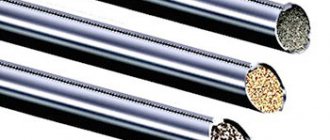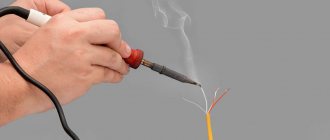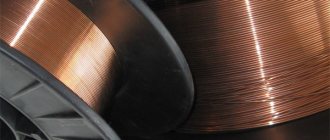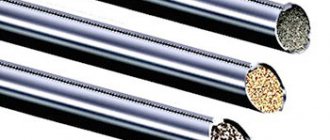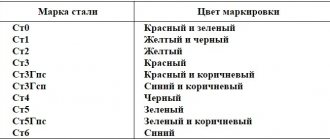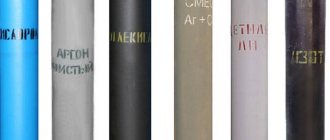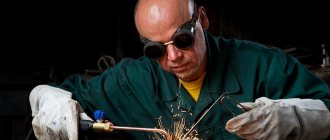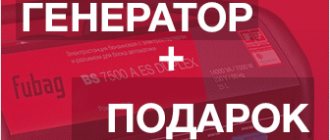Types of products and chemical elements in the composition
SV08G2S is available in two versions: non-copper-plated and copper-plated. In the latter case, the letter “O” is added to the designation.
The copper-plated version is available in diameters from 0.8 to 1.6 millimeters, and the non-copper-plated version is available in diameters from 0.6 to 6 millimeters.
The composition of SV08G2S a includes the following chemical elements:
- Carbon - from 0.05 to 0.11%.
- Manganese - from 1.8 to 2.1%.
- Silicon - from 0.7 to 0.95%.
- Sulfur - less than 0.025%.
- Phosphorus - less than 0.03%.
- Copper - up to 0.25% in non-copper-bonded and 0.3% in copper-bonded.
Sv-08G2S non-copper-plated
The composition of SV08G2S welding wire also includes up to 0.25% Ni and up to 0.2% Cr.
BRANDS AND CLASSIFICATION
1.1. The wire must be made of the following grades:
low-carbon - Sv-08, Sv-08A, Sv-08AA, Sv-08GA, Sv-10GA and Sv-10G2;
alloyed - Sv-08GS, Sv-12GS, Sv-08G2S, Sv-10GN, Sv-08GSMT, Sv-15GSTYUTSA (EP-439), Sv-20GSTUA, Sv-18KhGS, Sv-10NMA, Sv-08MH, Sv-08KhM , St. -08ХН2М, Sv-10ХН2ГМТ (ЭИ-984), Sv-08ХН2ГМТА (EP-111), Sv-08ХН2ГМУ, Sv-08ХН2Г2СМУ, Sv-06Н3, Sv-10Х5М;
high-alloy - Sv-12Х11НМФ, Sv-10Х11НВМФ, Sv-12Х13, SV-20Х13, Sv-06Х14, Sv-08Х14GNT, Sv-10Х17Т, Sv-13Х25Т, Sv-01Х19Н9, Sv-04Х19Н9, Sv-08Х16Н8М2 (EP-377) . 9Н10М3Т, Sv-08Х19Н10М3Б (EI-902) Sv-07Х25Н13, Sv-08Х25Н13БТУ (EP-389), Sv-13Х25Н18, Sv-08Х20Н9Г7Т, Sv-08Х21Н10Г6, Sv-30Х25Н16Г7, Sv-10Х16Н25AM6, Sv-09Х16Н25М6AF (EI-981А), Sv-01Х2 3N28M3D3T (EP-516) , Sv-30Х15Н35В3Б3Т, Sv-08Н50 and Sv-06Х15Н60М15 (EP-367).
(Changed edition, Amendment No. 2).
1.2. According to purpose, the wire is divided into:
for welding (surfacing);
for the manufacture of electrodes (symbol - E).
The purpose of the wire must be specified in the order.
1.3. Based on the type of surface, low-carbon and alloy wire is divided into:
non-copper-plated;
copper-plated - (O).
Special requirements for copper plating of the wire surface (including the total copper content) are established by technical specifications approved in the prescribed manner.
The need to supply wire with a copper-plated surface is specified in the order.
(Changed edition, amendment No. 2).
1.4. At the consumer's request, the wire must be made from steel smelted by electroslag (SH) or vacuum-arc (VA) remelting or in vacuum induction furnaces (VI). In this case, additional requirements for the wire metal (tightening standards for the content of harmful and foreign impurities, introducing restrictions on the content of gases, non-metallic inclusions, etc.) are established by agreement of the parties.
mechanical characteristics
Manufacturers are required to conduct strength tests. Each batch of welding wire 08g2s must meet the following standards:
| Diameter, mm | Tensile strength, kgf/mm2 | |
| surfacing | Welding | |
| Less than 1.5 | 89-136 | — |
| 1,6 | 89-136 | 69-101 |
| 2,0 | 79-121 | 69-101 |
| Over 2 | 69-106 | 64-96 |
The relative elongation coefficient is at least 30%. The yield strength of the product should fall in the range of 415-440 MPa. The value of the impact strength of the material measured at 40 °C is 56, and at 20 °C is 69 J/cm2.
GOST standards also standardize some other characteristics of SV08G2S.
ANNEX 1
DETERMINATION OF THE CONTENT OF FERRITE PHASE DURING STEEL MELTING AND IN WELDING WIRE
1. Determination of the ferrite phase content is carried out by the magnetic method using a ferritometer type FC-2.
(Changed edition, Amendment No. 2).
2. From each sample or from each sample taken as specified in clause 4.6 of this standard, at least two control samples are made, the dimensions of which must correspond to those indicated in the table.
mm
| Purpose of control sample | Diameter (limit deviation ± 0.1) | Length (limit deviation ±1) |
| To determine the α-phase content during steel smelting | 7 | 60 |
| To determine the α-phase content in the wire | 5 | 60 |
3. Control samples for steel smelting are made from ladle samples of liquid metal poured into a cooled metal mold. The volume of samples taken must ensure the production of at least two control samples.
4. Blanks of control samples for determining the α-phase content in the wire are made by melting the wire into a cooled chill mold made of copper, grades M0 or M1 in accordance with GOST 859. Remelting of the wire is carried out by the electric arc method with a non-consumable tungsten electrode in an argon environment of the highest grade in accordance with GOST 10157.
5. Testing of control samples is carried out in accordance with the operating instructions for a ferritometer type FC-2.
Distinctive features
When choosing welding materials, both production technologists and home craftsmen are faced with a serious question. He needs to find wire or electrodes that provide high quality seam joints, are unpretentious to welding conditions, and, last but not least, are not too expensive. When compared, SV08G2S wire comes out ahead in many respects.
SV08G2S has the following features compared to other welding materials:
- promotes stability of the electric arc, reduces the risk of electrode sticking to the surface of the workpiece;
- supports a wide range of welding modes;
- compatible with most types of welding machines;
- allows you to minimize the splashing of molten metal;
- facilitates re-ignition of the welding arc;
- helps save other consumables, such as copper tips.
Automatic wire welding
The combination of these features allows us to weld strong and durable seams, with high-quality edge penetration, uniform in composition and with a minimum of porosity and other defects.
Application area
SV08G2S is widely used in machine-building industries, shipbuilding, for various repair work - wherever it is necessary to weld parts made of carbon steel alloys for general purposes. It is gaining popularity among owners of small auto repair shops and simply among home craftsmen.
Copper-clad wire is deservedly popular. The copper layer promotes increased conductivity due to reduced resistance at the point of contact. This property significantly increases the stability of the electric arc and increases the strength and, most importantly, durability of the suture material. This occurs due to the suppression of oxidative processes in the weld and heat-affected space.
A wide range of produced sections allows you to select the most suitable welding material for both small or thin-sheet parts, and for massive workpieces and large-sized structures. The two-millimeter model is often used for repairing small items, becoming popular in home workshops. The six-millimeter model is used in industrial settings because it requires powerful current sources.
Semi-automatic wire welding
SV08G2S is used:
- In manual mode in an atmosphere of pure Ar, and also together with CO2 - as an additive. It is introduced into the work area manually, melts and enters the suture material after crystallization. Welding is carried out with a tungsten infusible electrode.
- In semi-automatic welding in an Ar atmosphere.
- As an alloying additive in the weld pool. Flux forms a cloud of protective gases, and slag forms a hard surface that protects the material of the weld pool from oxidation during crystallization.
SV08G2S has the best compatibility with industrial automatic and semi-automatic devices. It helps you manually weld almost any carbon steel with high quality. The seam has excellent geometry and stable chemical composition. Experts especially note the unique properties of the wire for such operations as forming a seam bead and uniformly filling the welding gap between the edges of workpieces.
Deposition coefficient indicator SV08G2S
Surfacing works are used to correct the geometric shape and dimensions of workpieces in case of defects, as well as in a planned manner - to give certain areas of the surface of the product improved physical and mechanical properties. The deposition rate is one of the most important parameters of welding materials.
It characterizes the mass of the melt deposited over a certain period of time at a certain operating current.
Weld seam when welding with wire
The specific value of the coefficient is determined:
- chemical composition of the substance;
- presence of coating (copper-plated/non-copper-plated);
- polarity of the welding current (direct/reverse);
- type of current (AC/DC).
The deposition rate is measured in grams per ampere hour and for SV08G2S cannot fall below 8.5.
The surfacing index affects the technical and economic efficiency of surfacing operations and the amount of metal loss due to spattering and evaporation.
The melting coefficient of the base metal also depends on the deposition rate, which directly affects the strength characteristics and durability of the connection.
Decoding wire markings and its main advantages
The abbreviation Sv-08G2S only at first glance is an incomprehensible set of numbers and letters. It is easy to decipher: the two letters at the beginning of “Sv” mean that this is a welding material. “08” indicates the C content in hundredths of a percent; the letter “G” is established by GOST to indicate Mn. Manganese was added to streamline the crystalline structure of the weld. The following number “2” indicates the content of this element as a percentage. The letter "C" stands for Si, the absence of numbers means that the Si content is less than one percent. This element is added to improve physical and mechanical properties.
Maintaining the proportion of Si to Mn at 0.83 to 1.95 makes it possible to achieve stability of the chemical composition against the background of increased strength and durability of the weld.
Download GOST 2246-70
The wire also contains the other chemical elements mentioned above, such as nickel, chromium, copper, sulfur and phosphorus. According to GOST requirements, since their content is less than one percent, they are not reflected in the designation.
LABELING, PACKAGING, TRANSPORTATION AND STORAGE
5.1. Each skein must be tightly tied with soft wire in at least three places, evenly spaced around the perimeter of the skein.
5.2. Coils of wire from the same batch are allowed to be bundled into coils. The weight of one skein or coil should not exceed 80 kg. By agreement with the consumer, a weight of skeins or coils of more than 80 kg is allowed.
5.3. A metal label is attached to each skein (coil, coil, cassette) of wire, which should indicate:
a) name or trademark of the manufacturer;
b) symbol of the wire;
c) batch number;
d) technical control mark.
Transport marking - according to GOST 14192.
(Changed edition, Amendment No. 2, 4).
5.4. Each coil (coil, coil) of wire with a diameter of 0.5 mm or less must be wrapped in a layer of paper and packed in a thick wooden box in accordance with GOST 18617 or other containers (metal, cardboard, plastic), according to regulatory and technical documentation.
Each coil (coil, coil) of wire with a diameter of over 0.5 mm must be wrapped in a layer of paper, then in a layer of polymer film, non-woven materials or fabric made of chemical fibers.
When mechanized packaging, each coil of wire must be wrapped in a layer of cable crepe paper in accordance with GOST 10396 or KMV-170 grade paper or other crepe paper with equivalent protective properties or polymer film while simultaneously fixing the packaging with wire in accordance with GOST 3282 or other wire.
The following are used as packaging materials:
waxed paper in accordance with GOST 9569 (the use of two-layer paper in accordance with GOST 8828 or other paper that provides corrosion protection is allowed); polymer film according to GOST 10354, GOST 16272 or other polymer film;
containerized canvas stitched or glued fabric, stitching tape from textile industry waste or fabric from chemical fibers according to regulatory and technical documentation.
It is allowed to pack the wire in polyethylene film, and high-alloy wire - in non-woven materials and fabrics made of chemical fibers without a paper sublayer.
The type of packaging of wire produced on large-sized coils, in coils and coils of increased weight is established by agreement between the consumer and the manufacturer.
(Changed edition, Amendment No. 4).
5.5. For each packaged skein (coil coil), a metal label containing the data given in clause 5.3 is attached on top of the packaging.
Note. When packing wire in rigid containers, it is allowed to replace the metal label with a paper label glued to the container and containing similar data.
(Changed edition, Amendment No. 2, 4).
5.6. Each batch of wire must be accompanied by a certificate certifying the wire's compliance with the requirements of this standard.
The certificate states:
a) trademark of the manufacturer;
b) symbol of the wire;
c) heat and batch number;
d) condition of the wire surface;
e) chemical composition in percentage, including:
actual nitrogen content of alloyed and high-alloyed wire of grades not specified in clause 3.16;
actual residual content of aluminum and vanadium in high-alloy wire and tungsten in alloy and high-alloy wire;
f) content of the ferrite phase in the sample, in percent;
g) tensile test results;
h) net mass of wire in kilograms.
(Changed edition, Amendment No. 2).
5.7. Wire is transported by all types of transport in covered vehicles in accordance with the rules for the transportation of goods in force for this type of transport.
By agreement between the consumer and the manufacturer, it is allowed to transport wire on large spools weighing 1 ton or more in open vehicles.
5.8. The wire must be stored in a closed warehouse
5.7, 5.8. (Changed edition, Amendment No. 4).


